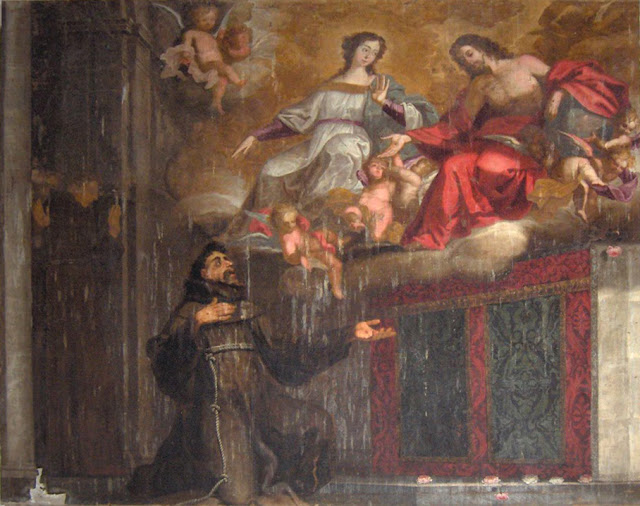Miracle of Porziuncola by Oliveira Bernardes 1698
The miracle of the Porziuncola, painting by Antonio de Oliveira Bernardes (1698). Cathedral of Evora, Portugal
Born in Beja, where he was baptized on December 10, 1662, he was the son of the painter Pedro Figueira and Isabel Rodrigues. In the 1670s, he moved to Lisbon. His apprenticeship took place within the family and in the workshop of the painter Marcos da Cruz, who died in 1683. He worked in the workshop of the court decorator, Francisco Ferreira de Araújo, whose daughter he married in 1694. He joined the brotherhood of S. Lucas in 1683 and was judge of this institution in 1694.
Painter of tempera and oil, he was mainly known as a tile painter. His workshop, located in the Olarias district, Santa Catarina, in Lisbon, was the most important school of tile painters of its time. His son, Policarpo de Oliveira Bernardes (1695-1778), also a tile painter, replaced him in 1727, when he fell ill, succeeding him as director of the workshop after his death on December 4, 1732. on Rua das Casas Caídas, parish of Santa Catarina do Monte Sinai, in Lisbon.
Among his students are, in addition to Policarpo, another son, Inácio de Oliveira Bernardes (1697-1781), painter, architect and set designer, André Gonçalves (1692-1762), oil painter, and some of the main tile masters from the period of the “great Joanina production”: Teotónio dos Santos (act. 1715-1730) and Nicolau de Freitas (1703-1765). His workshop also influenced other industrious tile painters, such as the “master of the P.M.P” (act. 1711-1725), Valentim de Almeida (1692-1779) and Bartolomeu Antunes (1688-1753).
Among his works, some signed, others documented or merely attributed, in the tempera and oil paintings, the ceiling of the nave of the church of Nossa Senhora dos Prazeres in Beja and the chancel of the church of Bonfim in Beja stand out. Setúbal (1690), that of the chapel of Nossa Senhora da Quinta da Ramada, in Frielas (c. 1698), reinstalled in 1918 in the dining room of Casa de Santa Maria in Cascais, and those of the chancel and nave of the church of Convent of Santa Clara in Évora (c. 1700).
In the tile painting, the ashlars in the same chapel as Nossa Senhora da Quinta da Ramada and those covering two rooms of the Palácio Tancos, in Lisbon, deserve to be highlighted. He is also responsible for some of the most notable tile coverings for vaults, for example in the old chapel of Nossa Senhora da Conceição, in the parish church of Mercês, in Lisbon (c. 1714); in the corridor of the sacristy of the sanctuary of Nossa Senhora da Nazaré (c. 1714); in the chancel of the church of the Franciscan Third Order in Faro (1718/19) and in the nave of the sanctuary of Nossa Senhora dos Remédios in Peniche (c. 1720), the latter possibly in partnership with his son Policarpo.


Comments
Post a Comment